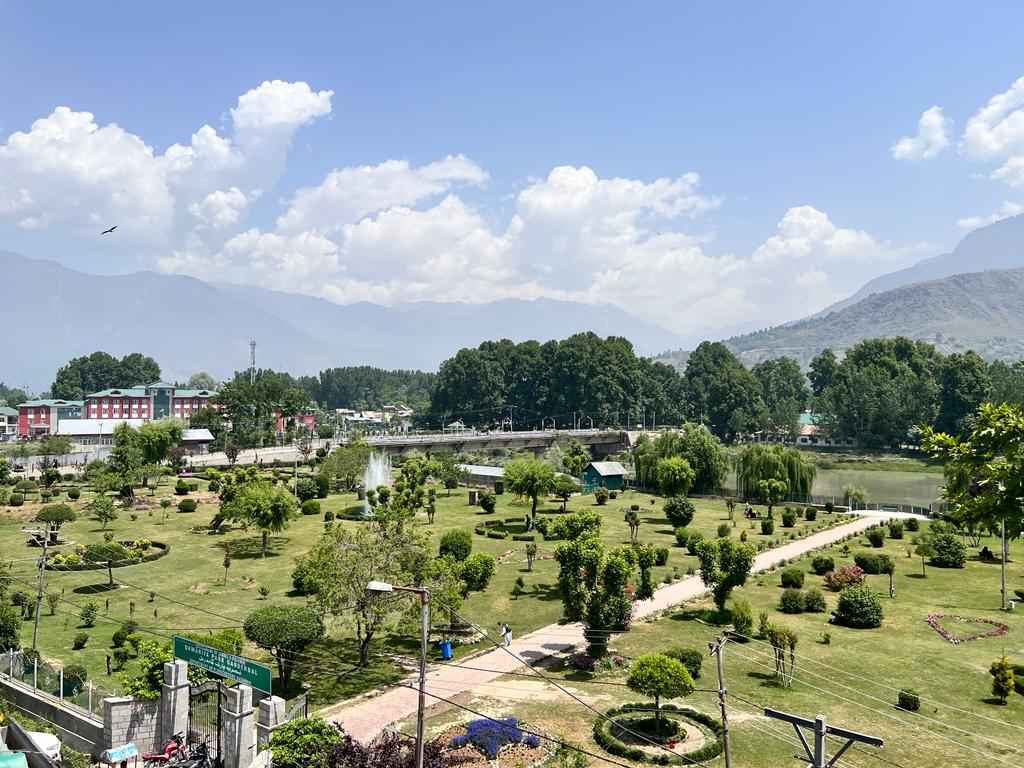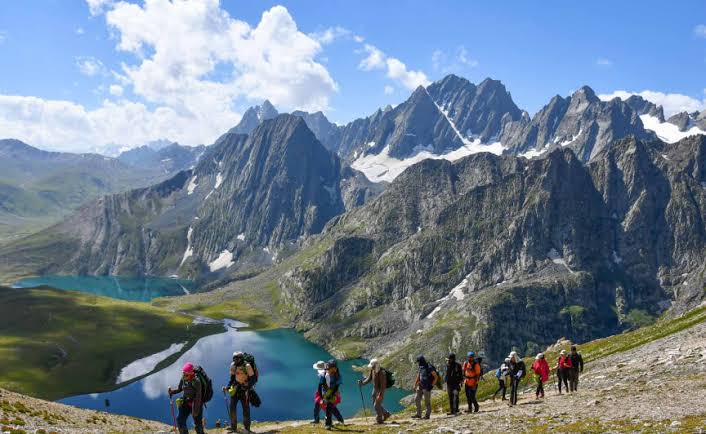The Ganderbal (گاندربل) district, or more formally District Ganderbal, is an administrative district of Jammu and Kashmir (UT)

Ganderbal town is administrative headquarters of district. It was formed in 2007 and has 6 subdistricts (tehsils): Kangan, Ganderbal, Tullamulla, Wakura, Lar, and Gund.
Kheer Bhawani
Kheer Bhawani is a temple dedicated to the goddess Bhavani, constructed over a sacred spring in Tulmul village.  The term kheer refers to rice pudding that is offered in the spring to propitiate the Goddess, which became part of the name of the temple. As is the custom with several Hindu deities.
The term kheer refers to rice pudding that is offered in the spring to propitiate the Goddess, which became part of the name of the temple. As is the custom with several Hindu deities.
Naranag Temple
The Naranag Temple is one of the important archaeological sites of the country. The ancient pilgrimage site is a group of several temples and is situated in the Naranag village near Harmukh Mountain about 50 kilometres (31 mi) from Srinagar city. The ancient name for the place is Sodarteertha; Bhuteshwara (now But Sher, midway on the trek to Gangbal lake) and Nandikshetra (Nundkol lake area) are two other holy sites associated with it. The site consists of a cluster of temples facing each other at a distance of about 100 metres (330 ft). Historians say that the temple is dedicated to Lord Shiva by the eighth-century ruler Lalithdatiya Muktapid. It is believed that the King Awantivarman paid a visit and donated a pedestal for bathing at Bhutsher. Even today one gets surprised over art and skill of the builders of this temple.
The ancient name for the place is Sodarteertha; Bhuteshwara (now But Sher, midway on the trek to Gangbal lake) and Nandikshetra (Nundkol lake area) are two other holy sites associated with it. The site consists of a cluster of temples facing each other at a distance of about 100 metres (330 ft). Historians say that the temple is dedicated to Lord Shiva by the eighth-century ruler Lalithdatiya Muktapid. It is believed that the King Awantivarman paid a visit and donated a pedestal for bathing at Bhutsher. Even today one gets surprised over art and skill of the builders of this temple.
Its impressive architecture reveals the glorious past, the magnificent art of the eighth century.
The government has only recently constructed walls to protect it from encroachments and nothing else has been done. It is now left in ruins of which only faint traces have survived.
Geography
- Kangan
- Ganderbal
- Tullamulla
- Wakoora
- Lar
- Gund
It is further divided into nine CD blocks: Ganderbal, Wakoora, Lar, Kangan, Gund, Shearpathri, Phaag, Manigam and Batwina.Each block consists of a number of panchayats. Ganderbal District has 2 assembly constituencies: Kangan and Ganderbal
Harmukh (also known as Mount Haramukh or Harmukh mountain) is a mountain with a peak elevation[23] of 16,890 ft (5,148 metres), in Ganderbal district of Jammu and Kashmir. Harmukh is part of the Himalaya Range, and is located between Sindh River to its south and Kishanganga River to its north. It rises above the Gangabal Lake in the vicinity of Kashmir Valley.[24] It is more hazardous to reach Mount Haramukh from the east and south side of Ganderbal and has never been climbed from these sides; thus, it is mostly climbed in the north-west from the Arin Bandipore side.
Harmukh was first climbed by the Great Trigonometric Survey‘s Thomas Montgomerie in 1856 and made the first survey of the Karakoram some 210 km (130 miles) to the south, and sketched the two most prominent peaks, labelling them K1 and K2.[25] Harmukh was later climbed by many other climbers.[26] Therefore, Harmukh is the mountain from which the world’s second highest mountain peak K2 was discovered and the Serveyer’s mark K2 continues to be the name.
Tourism
- Sonamarg

This famous hill station is situated 80 kilometres (50 mi) from Srinagar and located on the banks of Sindh River at an altitude of 2,800 meters. Sonamarg also hosts the International Championships of Rafting on Sindh River. It presents a glamorous look due to its alpine meadows, snow-clad mountains, and healthy climate. Sonamarg skirts Sindh River and torrential flow of water in this river enriches its awesome beauty. Besides several hotels in private sector have come up here and these hotels provide modern facilities to their guests. A number of treks in this region also begin from Sonamarg to high altitude lakes of Vishansar, Krishansar, Gadsar and Gangabal stocked with snow trout and brown trout.
Manasbal Lake
Manasbal Lake is the main attraction for tourists in Ganderbal district, 12 kilometres (7.5 mi) north west of district headquarters of Ganderbal. It is 5 kilometres (3.1 mi) long and 1 kilometre (0.62 mi) wide.  It is located in the Jhelum valley, north of Srinagar city in Jammu and Kashmir. The name Manasbal is said to be a derivative of the Lake Manasarovar.[15] Lake is encircled by three villages: Jarokbal, Kondabal (also called Kiln place; is situated on the north-eastern side of the lake) and Ganderbal and is stated to be the deepest lake (at 13 m or 43 ft depth) in the Kashmir valley. The large growth of lotus (Nelumbo nucifera) at the periphery of the lake (blooms during July and August) adds to the beauty of the clear waters of the lake. The Mughal garden, called the Garoka, (meaning bay window) built by Nur Jahan overlooks the lake.[16]
It is located in the Jhelum valley, north of Srinagar city in Jammu and Kashmir. The name Manasbal is said to be a derivative of the Lake Manasarovar.[15] Lake is encircled by three villages: Jarokbal, Kondabal (also called Kiln place; is situated on the north-eastern side of the lake) and Ganderbal and is stated to be the deepest lake (at 13 m or 43 ft depth) in the Kashmir valley. The large growth of lotus (Nelumbo nucifera) at the periphery of the lake (blooms during July and August) adds to the beauty of the clear waters of the lake. The Mughal garden, called the Garoka, (meaning bay window) built by Nur Jahan overlooks the lake.[16]
The lake is a good place for birdwatching as it is one of the largest natural stamping grounds of aquatic birds in Kashmir and has the sobriquet of “supreme gem of all Kashmir Lakes”.[17][18] The rootstocks of lotus plant which grows extensively in the lake are harvested and marketed, and also eaten by the local people.[15]
The lake is approached from Srinagar by a 30-kilometre (19 mi) road via Shadipur, Nasim and Gandarbal. Road to Wular Lake, the largest lake in Kashmir, passes through this lake, via Safapur.[15]
Mohand Marg
Mohand Marg is an alpine meadow in the Lar tehsil. In summer it is a tourist destination for trekking and camping. Sir Aurel Stein was the first person to explore the place, pitching his camp in the summer of 1895.[19][20][21][22]

It is hidden in the mountains to the north of Srinagar at the foot of Haramukh Peaks about 25 kilometers from Srinagar via the Ganderbal road towards Leh. From the road it is accessed via 5 kilometer trek up a steep path through the hill-side settlements and fields of Lar and Chount Waliwar before the ‘Marg’ opens out across the mountain side giving views of the Sindh Valley far below in one direction and the Valley of Kashmir in the other.
Harmukh
 Gangabal Lake at foothills of Harmukh
Gangabal Lake at foothills of HarmukhHarmukh (also known as Mount Haramukh or Harmukh mountain) is a mountain with a peak elevation[23] of 16,890 ft (5,148 metres), in Ganderbal district of Jammu and Kashmir. Harmukh is part of the Himalaya Range, and is located between Sindh River to its south and Kishanganga River to its north. It rises above the Gangabal Lake in the vicinity of Kashmir Valley.[24] It is more hazardous to reach Mount Haramukh from the east and south side of Ganderbal and has never been climbed from these sides; thus, it is mostly climbed in the north-west from the Arin Bandipore side.
Harmukh was first climbed by the Great Trigonometric Survey‘s Thomas Montgomerie in 1856 and made the first survey of the Karakoram some 210 km (130 miles) to the south, and sketched the two most prominent peaks, labelling them K1 and K2.[25] Harmukh was later climbed by many other climbers.[26] Therefore, Harmukh is the mountain from which the world’s second highest mountain peak K2 was discovered and the Serveyer’s mark K2 continues to be the name
Gangabal Lake
Gangabal Lake, also called Gangbal Lake, is a lake situated at the foothills of Mount Haramukh (one of the highest mountain peak in the vicinity of Kashmir valley)[27] in Ganderbal district, north of Srinagar city in Jammu and Kashmir in India.  It is an alpine high altitude oligotrophic lake,[28] and is home to many types of fishes[29] of which one is the brown trout.[30]
It is an alpine high altitude oligotrophic lake,[28] and is home to many types of fishes[29] of which one is the brown trout.[30]
The lake has a maximum length of 2.5 kilometres (1.6 mi) and maximum width of 1 kilometre (0.62 mi). It is fed by precipitation, glaciers and springs. The lake water outflows to a nearby small lake (Nundkol)[31] and then via Wangath nullah[32] to Sindh River.[33] The trout fishes are present in the lake.[34] Gangabal lake is approached from Srinagar 45 kilometres (28 mi) by road via Ganderbal up to Naranag[35] and then a 15 kilometres (9.3 mi) track upslope.

Ganderbal Press Association is an union of journalists, with an aim to strive towards common goals of professional journalism. The association seeks to enhance the journalists fraternity to serve and act as a mirror that reflects the natural picture not animated, our society is going through.

